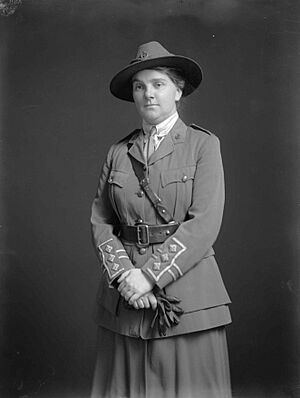Elizabeth Gunn (paediatrician) facts for kids
Quick facts for kids
Elizabeth Gunn
|
|
|---|---|
 |
|
| Born |
Elizabeth Catherine Gunn
23 May 1879 Dunedin, New Zealand
|
| Died | 26 October 1963 (aged 84) Wellington, New Zealand
|
| Occupation | Paediatrician |
| Years active | 1912–1940 |
| Known for | Establishing Children's Health Camp movement in New Zealand |
| Medical career | |
| Profession | Doctor |
| Field | Paediatrics |
Elizabeth Catherine Gunn (23 May 1879 – 26 October 1963) was a New Zealand doctor. She worked as a school doctor and served in the army. She was also a public health official.
Elizabeth Gunn was a leader in children's health. She was very important in starting the children's health camp movement in New Zealand. These camps helped many kids get healthier.
Contents
About Elizabeth Gunn
Early Life and Education
Elizabeth Gunn was born in Dunedin, New Zealand, in 1879. Her father was an ironmonger, which means he sold metal goods. He later became a pharmacist and then a dentist.
Elizabeth went to school at Timaru and Otago Girls' High School. After a year at the University of Otago, she moved to Scotland. She finished her medical training at Edinburgh Medical School in 1903. She then studied more about childbirth in Dublin, Ireland.
Becoming a Doctor and Army Service
After her studies, Elizabeth Gunn came back to New Zealand. She worked as a general doctor in Wellington. In 1912, she joined the school medical service. This meant she helped keep students healthy.
From 1915 to 1917, she was a captain in the New Zealand Medical Corps (NZMC). This was during World War I. It was hard for women to join the army as doctors back then. But Elizabeth was very determined. When she was first told no, she went straight to the Prime Minister, William Massey. She argued that not letting her join was unfair to her reputation as a doctor.
She served with the NZMC at Trentham. She also worked on a troopship called the Tahiti. After returning to New Zealand, she continued working at Trentham. However, she became unwell with a rheumatic condition.
Helping Children's Health
While recovering, Elizabeth Gunn traveled to Britain in 1917. There, she visited places that helped children. She saw how many children were not getting enough food. This made her very aware of the problem of child malnutrition.
When she returned to New Zealand, she rejoined the school medical service. She worked in the southwestern North Island. During this time, she became known for her strong personality. She was respected, but also a bit feared! She was known for sometimes removing loose or decayed teeth from children herself.
Starting Health Camps
Elizabeth Gunn's biggest contribution was starting the Children's Health Camp movement. She got the idea from "open-air schools" in Britain. These schools helped people with illnesses like tuberculosis by letting them spend time outdoors.
Gunn suggested that simple camps could help children who were not getting enough food. She worked with B.P. Lethbridge, a member of the Wanganui Hospital Board. They made a friendly bet about whether the camps would work. Elizabeth then used her skills to get everything needed for the first camp.
In November 1919, 55 children arrived at Turakina. They spent three weeks there. Elizabeth Gunn, along with nurses and teacher trainees, looked after them.
Growing the Health Camp Movement
Elizabeth Gunn kept organizing and running these camps herself throughout the 1920s. They were held at Turakina and later at Awapuni, Palmerston North. Her last camp was in 1930.
The camps had a very organized schedule, almost like a military camp. They were a mix of an outdoor hospital and a scout camp. Other volunteer health camps also started up. In 1936, a National Federation of Health Camps was formed. This group created permanent, year-round facilities. The government also provided money for the camps. Some of this money came from selling health stamps. These were special postage stamps that included a small extra charge for charity. This money went to help run the camps.
Later Years and Legacy
From 1937 to 1940, Elizabeth Gunn was the director of the Health Department's Division of School Hygiene. She retired from this role in 1940. Even after retiring, she remained very interested in child health.
In 1951, she was made a Member of the Order of the British Empire (MBE). This award recognized her important work in child health. Elizabeth Gunn passed away in Wellington in 1963. Her work helped create a lasting system to improve the health of children in New Zealand.


